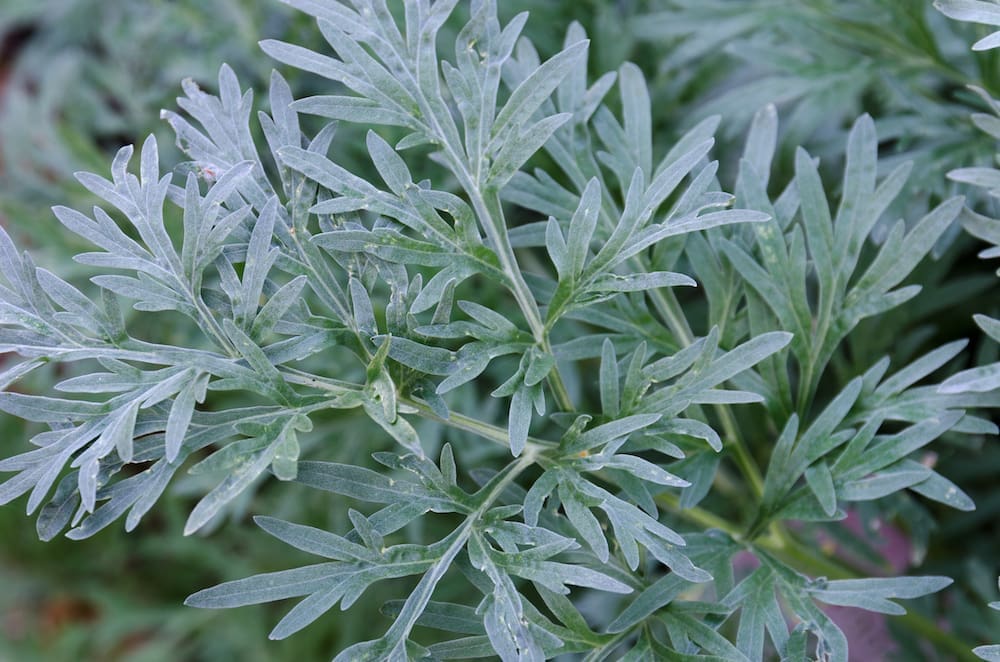
Absinthium
Latin name: Artemisia absinthium
Short name: Absin
Common name: Wormwood | Common Wormwood | Green Ginger | Absinthe | Grand Wormwood
Primary miasm: Sycotic Secondary miasm(s): Syphilitic
Kingdom: Plants
Family: Asteraceae (Compositae)
- Symptomatology
- Remedy Information
- Differentiation & Application
Artemisia absinthium is a perennial aromatic herb of the Asteraceae family, native to temperate regions of Europe, Asia, and North Africa, and now naturalised in parts of North America. The plant is characterised by its silver-green foliage and intensely bitter taste. Its essential oil contains thujone, a neurotoxic ketone that, in large doses, can provoke convulsions and hallucinations. Historically, wormwood formed the principal ingredient of the alcoholic spirit Absinthe, notorious in 19th-century Europe for its supposed artistic inspiration and its dangers. In homeopathy, the fresh, flowering tops are macerated in alcohol to prepare the mother tincture. The remedy acts profoundly on the brain and nervous system, producing both mental and physical excitation, spasmodic activity, and a peculiar state of half-consciousness marked by vivid hallucinations and loss of memory.
Traditionally used as a vermifuge (anthelmintic) and bitter tonic to stimulate appetite and digestion. In the 18th and 19th centuries, wormwood was a common ingredient in aperitifs and the infamous spirit Absinthe. Herbalists employed it for sluggish digestion, gall-bladder complaints, and as an aromatic bitter to strengthen convalescents. Overuse in herbal or distilled form has been associated with “absinthism” — a toxic neurological syndrome with tremors, seizures, and hallucinations.
Introduced into homeopathic use by Dr. W. E. Payne in the mid-19th century [Allen]. The proving elicited states of delirium, hallucination, tremors, and spasms. Clinical use soon confirmed its value in certain epileptiform states and delirium tremens.
- Cerebro-spinal nervous system – Spasms, epileptiform seizures, tremors [Clarke].
- Mind and intellect – Sudden loss of memory, confusion, hallucinations [Allen].
- Special senses – Hyperaesthesia, visual disturbances.
- Muscles – Trembling, convulsive movements.
- Digestive organs – Irritation from its intensely bitter principle.
- Lying down in a quiet, darkened room (reduces sensory overload)
- Avoiding stimulants such as alcohol and strong coffee
- Rest after spasmodic episodes
- Fresh, cool air in mild, non-stimulating surroundings
- Mental or physical overexertion [Kent]
- Strong odours, noise, or bright light (precipitates nervous agitation)
- Alcoholic beverages, especially spirits (may trigger convulsions) [Clarke]
- Emotional excitement or sudden fright
- Worm infestations (especially in children), which can aggravate nervous phenomena
- Cicuta virosa – More violent opisthotonos; less memory loss between seizures.
- Hyoscyamus – Loquacious delirium with lasciviousness; more fear of being poisoned.
- Artemisia vulgaris – More chronic epileptic tendency, less acute hallucination.
- Belladonna – Red, hot face and violent delirium; more congestion to head.
- Stramonium – Intense fear, violent mania; less amnesia.
- Complementary: Cina (in worm-related convulsions), Nux vomica (in alcoholics).
- Antidotes: Nux vomica, Camphora (for toxic overdoses).
- Inimical: Avoid repetition alongside strong cerebral stimulants.
A state of sensorial and motor derangement marked by amnesia, hallucinations, tremors, and convulsions, often precipitated by toxic, parasitic, or alcoholic influences. The keynote is the obliteration of recent memory in the midst of nervous excitement. The patient alternates between states of wild mental activity and dull stupor.
Particularly useful in post-epileptic states where the patient cannot recall the seizure or events preceding it [Clarke]. Valuable in delirium tremens when hallucinations are less terrifying than those of Stramonium but accompanied by profound memory loss. Low potencies (1x–3x) often used in acute nervous states; higher potencies for chronic epileptiform tendencies.
Mind
- Memory, loss of recent events
- Delirium, alternating with stupor
- Hallucinations, visual
- Confusion of mind, cannot recognise friends
Head
- Vertigo, objects turn in a circle
- Heaviness of head with dullness
Eyes
- Vision, objects appear multiplied
- Pupils dilated, during convulsions
Stomach
- Appetite lost, with faintness
- Nausea, with nervous excitement
Extremities
- Trembling of hands
- Convulsions, epileptiform
Generalities
- Convulsions, from alcohol
- Epileptic fits, with loss of memory afterwards
Allen, T. F., Encyclopaedia of Pure Materia Medica – First proving records; memory loss; hallucinations; convulsions.
Clarke, J. H., A Dictionary of Practical Materia Medica – Hallucinatory states, worm-related nervous symptoms, post-epileptic confusion, delirium tremens indications.
Hering, C., Guiding Symptoms of Our Materia Medica – Description of vertigo, motor spasms, alternations of excitement and stupor.
Kent, J. T., Lectures on Homeopathic Materia Medica – Modalities; aggravations from alcohol and exertion.
Hale, E. M., New Remedies – Nervous states from worm infestation; tremors; spasmodic conditions.
